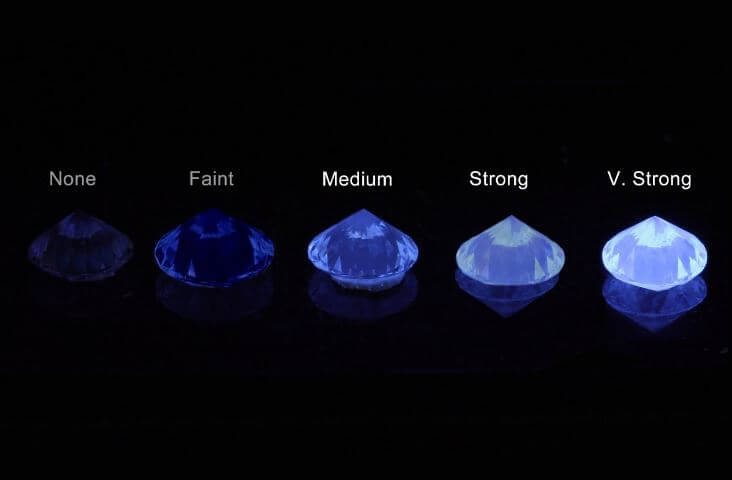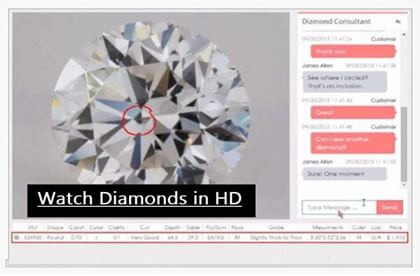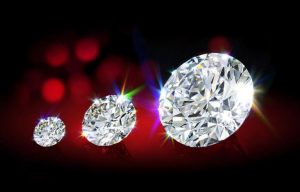Executive Summary
This is a phenomenon known to be present in about 30% of all diamonds. Diamond fluorescence is the term used to describe the tendency of a diamond to emit a glow with a soft coloration when ultraviolet light is passed on the diamond. Fluorescence occurs in a diamond when trace elements like aluminum, nitrogen, and boron in and around the site of crystallization find their way into the crystallizing diamond and infiltrate the atomic structure of the diamond. The degree of fluorescence will be determined by how much boron is able to infiltrate the crystallizing diamond. A diamond fluorescent color can be blue, green, yellow, white and orange. But the most common diamond fluorescent color is blue.
Like many other diamond attributes, fluorescence is also graded and on the fluorescence scale, there are 5 levels.
None: Lack fluorescence
Faint blue: Very little fluorescence that the diamond is almost unaffected by it. The diamonds are not usually hazy.
Medium blue: Affects the diamond a little but they aren’t usually hazy as well. It is good on diamonds in the color grade range of H-K. It makes them appear whiter.
Strong: Diamonds appear hazy, not recommended. It has a worse effect on the D-F diamonds even if they’re in the best color grade of diamonds.
Very strong: The effect is stronger on the diamonds and they appear very hazy. These diamonds are not recommended for buyers.
Fluorescence in diamonds affects the value of the diamond. D-F diamonds always sell for at least 15% off if they have fluorescence. Because they are colorless diamonds, the blue coloration of the fluorescence affects the diamonds. Other diamonds with yellow coloration (I-M) are sold at a premium price if they have fluorescence. This is because yellow and blue complements each other very well, so they leave the diamond whiter than it should be. Thereby increasing its market value.
This is a very popular phenomenon with diamonds and diamond buyers and sellers. Diamond fluorescence is the term used to describe the tendency of a diamond to emit a glow with a soft coloration when ultraviolet light is passed on the diamond. About 30 of all diamonds are known to exhibit some degree of this fluorescence.
It has been a major argument in past times whether fluorescence in a diamond is good or bad. There are two ways to view it, especially from the buyer’s perspective. For example, the colorless diamonds (within the color grade of D – F) are sold for as much as 15 off their normal price if they have fluorescence. In this case, fluorescence is seen as a defect in these colorless diamonds. But if the fluorescence is just a faint to medium fluorescence, it can only be perceived by a gemologist when they view the diamond with a special ultraviolet light source. Another instance is the I – M color grade diamonds selling for a higher price than normal because of the ‘whiter’ than they should. This is caused by fluorescence. The color of the fluorescent glow that diamonds give is blue and this color complements the yellow color in the diamonds making them appear whiter than they truly are. This is why I – M diamonds that have a fluorescence of medium to very strong sell for a higher price.
If you have followed through up until this point, you would have noticed terminologies like faint to medium fluorescence, medium to very strong fluorescence. These terms refer to the diamond fluorescence scale.
Diamond Fluorescence Scale
Like diamond color and clarity, the fluorescence also has its own scale for grading the degree of fluorescence in diamonds. There are 5 different levels of fluorescence in diamonds according to the GIA. The different grades are none, faint, medium, strong and very strong. These grades describe the different intensity of fluorescence in diamonds when they are compared to master stones in the lab.
None: Only about 30 of diamonds exhibit fluorescence. So there are a lot of diamonds that do not show this fluorescence under ultraviolet light. There’s usually a reference stone used to measure fluorescence in diamonds. When a diamond does not exhibit fluorescence or the fluorescence shown is weaker than the reference stone, the fluorescence grade is marked “none”.
Faint Blue Fluorescence: This is the least grade for diamond fluorescence. Diamonds with faint fluorescence are usually not hazy. This means that the diamonds are not really affected by the fluorescence. So you can buy a diamond with this grade of fluorescence and it wouldn’t be so obvious. This fluorescence grade goes best with the grade G diamond or a lower color grade. It definitely will save you some cash and you wouldn’t be missing out on the overall brilliance of the diamond.
Medium Blue Fluorescence: This is a level of fluorescence in a diamond. Just like the faint blue fluorescence as well, the diamonds are usually not hazy as well. This fluorescence grade are best fits for diamonds with color grades of H – K. It makes them appear whiter than they are. Fluorescence in cases like these is an advantage to the buyers they allow you to go down the color scale, buy a way cheaper diamond and yet without the yellow coloration that it should normally possess. When determining a diamond to buy, if you don’t mind, you should look out for fluorescence as it can save you a lot of cash.
Strong Fluorescence: Diamonds with a strong fluorescence usually appear hazy. They are not diamonds that we would recommend that you buy. The diamonds that usually affected more by this fluorescence are those within the D – F color grade. They are usually very hazy. Although, these color grades are the best available, when they combine with strong fluorescence in the diamond they appear very hazy.
Very Strong Fluorescence: They have the same characteristic as the fluorescence grade above them. The difference is the influence of the fluorescence is stronger and so the diamonds appear hazier especially D – F color grade diamonds. Diamonds with this very strong fluorescence are definitely not recommended as well.
How Fluorescence Affect the Price of Diamonds
Depending on the color grade of the diamond, fluorescence can either be a good or a bad thing. Fluorescence can enhance the color and beauty of a diamond and it can as well detract a diamond from its beauty.
The color of diamond fluorescence is blue. When a diamond is also said to have colors, (except fancy diamonds which may have various shining colors), the color is referred to as a yellow coloration in diamonds. The good thing here is that yellow and blue are colors that complement each other. So when faint yellow coloration meets with faint blue coloration in a diamond, the colors sort of cancels each other out. Leaving us with a white diamond. This is why fluorescence is a good thing for diamonds in the middle of the color grade with just faint yellow coloration (I – M). It enhances the appearance of the diamonds. That is why I – M diamonds with faint blue or medium fluorescence usually sell at a premium.
The reverse is the case when it comes to colorless diamonds high up the color grade (D – F). When these diamonds have fluorescence in them, it is seen as a flaw so it definitely reduces the value of the diamond. As a matter of fact, fluorescence in these diamonds makes them appear hazy and oily. This definitely wouldn’t sit well with the buyers and so to compensate for this unfavorable characteristic, the price of the diamond is lowered. It is sold at a discount lower than the normal price for the D – F color grade diamonds.
The table below shows the estimated discount that is cut off the different grades of diamond color concerning the strength of the fluorescence in the diamond. The cut quality and carat size of the diamonds used for making this table is similar.
| None | Faint fluorescence | Medium fluorescence | Strong fluorescence | Very strong fluorescence | |
| D | 0.0 | – 6.4 | – 14.3 | – 21.9 | – 25.1 |
| E | 0.0 | – 6.6 | – 10.5 | – 19.5 | – 23.1 |
| F | 0.0 | – 5.1 | – 9.8 | – 17.8 | – 20.7 |
| G | 0.0 | – 4.2 | – 4.7 | – 11.1 | – 17.4 |
| H | 0.0 | – 4.4 | – 5.9 | – 9.8 | – 14.7 |
| I | 0.0 | – 3.2 | – 9.3 | – 11.9 | – 15.4 |
| J | 0.0 | – 2.8 | – 9.1 | – 14.2 | – 16.2 |
| K | 0.0 | – 2.7 | – 8.7 | – 14.7 | – 17.8 |
What Causes Diamond Fluorescence?
A lot has been said already about diamond fluorescence, how they affect the appearance of diamonds and the prices of diamonds but we are yet to discuss how they come about or how they are formed in diamonds in the first place.
Diamonds are crystallized carbon and this crystallization process occurs way below the surface of the earth where there are ancient and present volcanic sites. Fluorescence occurs in a diamond when trace elements like aluminum, nitrogen, and boron in and around the site of crystallization find their way into the crystallizing diamond and infiltrate the atomic structure of the diamond. The degree of fluorescence will be determined by how much boron can infiltrate the crystallizing diamond.
When a diamond containing these trace elements are subjected to energy from an ultraviolet source, the electrons in these elements absorb this energy and become excited. This excited state is a higher energy state. This higher state is not a stable state for the electron and these electrons always seek a way to return to a more stable state. The only way they do this is to get rid of excess energy in them. The excess energy is released in the form of photons and this released photon is what we see and call fluorescence in diamonds.
There is a lot of different colors in which a diamond can fluorescence. A diamond fluorescent color can be blue, green, yellow, white and orange. But the most common diamond fluorescent color is blue. The fluorescent color that a diamond shows depends a lot on the chemical composition of the diamond and the make-up of the diamond’s lattice structure during the formation of the crystallization process of the diamond. The estimated amount of diamonds with fluorescence is about 25 – 35 of all diamonds. Very few of these fluorescent diamonds show fluorescence strong enough to cause an obvious or noticeable difference to the color of diamonds under sunlight or low ultraviolet light. Otherwise, fluorescence is usually viewed and noticed under the ultraviolet lamp.
According to the GIA, the strength of a diamond fluorescence does not in any way correlate to the clarity or color of the diamond. This means that it is a big possibility for two diamonds to exhibit a very similar strength of fluorescence and yet have very different grades of color and clarity.
As it was mentioned earlier in the article, there are different levels of fluorescence in diamond; none, faint, medium, strong and very strong.
Tips on Diamond Fluorescence
- It is your choice to determine whether fluorescence on a diamond loos good or bad. We already mentioned the good and bad of fluorescence in diamond and how it affects the diamond. But ultimately, you as the buyer have to decide if you like it or not and if you are going to buy it or not.
- The color of a diamond can be improved by fluorescence. When a diamond has a faint or medium fluorescence, especially those with faint yellow coloration, the color of the diamond is improved. This can help you save some money by buying a “colored” diamond, that doesn’t appear colored but appears more brilliant than it normally is.
- Strong fluorescence in diamonds does not necessarily have to produce a negative effect on the overall appearance and color of the diamond.
- It would be a good idea to purchase your fluorescent diamonds only from trusted and reputable sellers to ensure that you are getting a high-quality diamond. You should also make sure that you check and confirm the return policy of the retailer just in case something goes wrong and you need to return it.
- One wise thing you can also do before buying a fluorescent diamond is to ask to check the diamond under ultraviolet light and compare it with normal light. You should also check to confirm how the diamond looks like under the natural daylight.
Is Fluorescence in Diamond A Good or Bad Thing?
Well, the answer is pretty obvious. Fluorescence in diamond is not necessarily a bad thing. Although, the stereotype is that it is bad and most people would rather prefer to stay away from the fluorescent diamond. But in reality, it doesn’t always have to be seen that way because it’s not necessarily bad. It can be good and even advantageous to you as the buyer. The issue with fluorescence in a diamond is that it is very misunderstood.
The truth is many people are intrigued by fluorescence in diamonds. Again, it boils down to personal preference. One thing that is true though is that fluorescence has little or no effect on the sparkle and brilliance of a diamond. That is almost solely determined by the cut of the diamond. Fluorescence in diamonds indeed can be bad too, no doubt. But this (whether the fluorescence is good for the diamond or bad) depends on certain factors. But the truth is there are pros and cons to diamond fluorescence.
Pros of Diamond Fluorescence
The obvious thing to be counted as an advantage for fluorescence in a diamond is the fact that it makes the diamond very cheap and very affordable. The very fact that a lot of people have this unfounded fear of fluorescence and always want to avoid it also drives the price of fluorescent diamonds way down. A typical example is a colorless diamond within the D – F grade usually sells for a discount as much as 15 – 30. The most surprising thing is even if the fluorescence is so little that it doesn’t affect the appearance of the diamond or doesn’t give it that haziness, the diamond still sells at a discount. That’s how much impact that fluorescence can have on a diamond price and this isn’t a bad thing, is it?
If you are a buyer working with a restricted budget or you are just someone who prefers to go for the faintly colored diamond (from I – M), then fluorescence will play well into your hands. It will allow you to get a ‘white-looking’ diamond at a very cheap price. And this will be an added advantage to your budget.
Cons of Diamond Fluorescence
The stigma of fluorescence making diamond look hazy is the reason why fluorescence is very unpopular with many consumers. This is not a lie though, but it is not necessarily true. It doesn’t happen with all diamonds with fluorescence but the stigma is there still. This makes it difficult to sell such diamonds because the fluorescence is seen as a defect (which it isn’t in all cases, and doesn’t have to be). The problem then lies very obviously for you as an owner of a fluorescent diamond and are looking to resell it in the future. The diamond becomes very difficult to resell. Getting a buyer for such a fluorescent diamond is very difficult. The most painful part of her is that you might be forced to sell the diamond for a very cheap price especially if you are actively looking for a way to move the diamond on.
In summary
- Fluorescence is the tendency of diamonds to emit a glow with a soft coloration when ultraviolet light is passed on the diamond. This glow is usually photons that the excited electrons in the diamonds give off to return to a stable state. Only 30 of all diamonds exhibit fluorescence.
- Fluorescence occurs in diamonds when a trace element like boron finds its way to the atomic lattice of the diamond during the process of crystallization of the diamond deep under the surface of the earth.
- The Fluorescence in diamond is divided into levels by the GIA based on the intensity of the fluorescence in comparison to a master stone used in the lab for this classification.
- Fluorescence has a negative stigma as being a bad feature present in some diamonds. But this is not necessarily true. Strong fluorescence is bad for colorless diamonds because it is known to give it a hazy appearance.
- Fluorescence can be good for a diamond and the buyer as well. It helps to improve the color of the near-colorless and faint yellow-colored diamonds, making them appear whiter than they look.
- Diamonds with fluorescence are cheaper and this is an advantage to the customer buying it.




